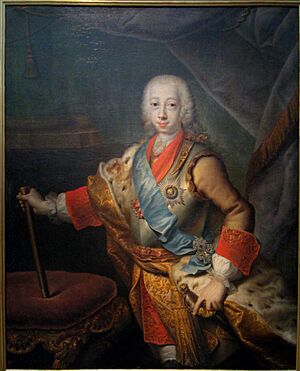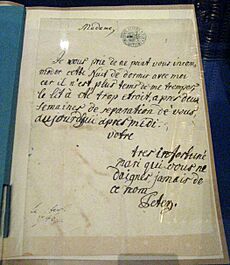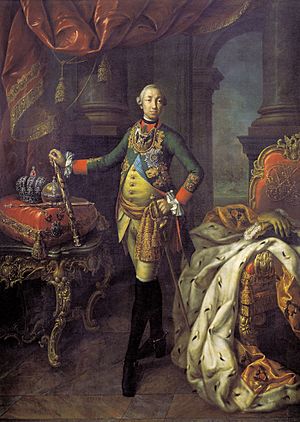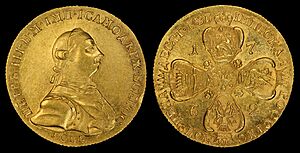Peter III of Russia facts for kids
Quick facts for kids Peter III |
|
|---|---|

Portrait by Lucas Conrad Pfandzelt, c. 1761
|
|
| Emperor of Russia | |
| Reign | 5 January 1762 – 9 July 1762 |
| Predecessor | Elizabeth |
| Successor | Catherine II |
| Duke of Holstein-Gottorp | |
| Reign | 18 June 1739 – 9 July 1762 |
| Predecessor | Charles Frederick |
| Successor | Paul |
| Born | Karl Peter Ulrich of Schleswig-Holstein-Gottorp 21 February 1728 Kiel, Holstein-Gottorp, Duchy of Holstein |
| Died | 17 July 1762 (aged 34) Ropsha, Russian Empire |
| Burial | Saints Peter and Paul Cathedral, Saint Petersburg |
| Spouse | |
| Issue |
|
| House | Romanov-Holstein-Gottorp |
| Father | Charles Frederick, Duke of Holstein-Gottorp |
| Mother | Grand Duchess Anna Petrovna of Russia |
| Religion | Russian Orthodox prev. Lutheran |
| Signature |  |
Peter III Fyodorovich (Russian: Пётр III Фёдорович; born 21 February [O.S. 10 February] 1728 – died 17 July [O.S. 6 July] 1762) was the Emperor of Russia for a short time in 1762. He ruled from January 5 to July 9 of that year. His wife, Catherine II, removed him from power.
Peter was born in the German city of Kiel. His birth name was Karl Peter Ulrich of Schleswig-Holstein-Gottorp. He was a grandson of Peter the Great, a famous Russian ruler.
Peter had trouble speaking Russian. He also favored Prussia, a country that Russia was fighting in the Seven Years' War. This made him unpopular with many Russians. When he became emperor, Russian troops were close to taking the Prussian capital, Berlin. Peter immediately stopped fighting Prussia and pulled his troops back. This undone the gains Russia had made in the war.
Troops loyal to his wife, Catherine, then removed him from power. Catherine, who was also German by birth, was a strong Russian nationalist. She became empress after him. Peter died soon after he was removed from power. Some historians believe his death was part of the plan to remove him. Others think it was an accident.
Even though his reign was short and he is often remembered poorly, Peter made some important changes. He allowed religious freedom and supported education. He also tried to make the Russian army more modern. He ended the secret police, which was known for being very harsh. He also made it illegal for landowners to kill their serfs (farm workers tied to the land) without a court trial. Catherine later continued some of his reforms.
Contents
Early Life and Family
Peter was born in Kiel, a city in the duchy of Holstein-Gottorp. His parents were Charles Frederick, Duke of Holstein-Gottorp, and Grand Duchess Anna Petrovna of Russia. His father was a grandson of Charles XI of Sweden. His mother was the daughter of the Russian monarchs Peter the Great and Catherine I.
Peter's mother died shortly after he was born. In 1739, his father died, and Peter became the Duke of Holstein-Gottorp at age 11.
When Peter's aunt, Elizabeth, became Empress of Russia, she brought Peter from Germany to Russia. In 1742, she named him her heir presumptive, meaning he was next in line for the throne. In October 1742, Peter also became the chosen heir to the Swedish throne. However, the Swedish parliament did not know he was also heir to the Russian throne. By the time their message reached Russia, it was too late.
In November 1742, Peter changed his religion to Eastern Orthodoxy and took the name Pyotr Feodorovich. He was also given the title Grand Duke of Russia. To show his strong claim to the Russian throne, his official title had to include "Grandson of Peter the Great." It was even a crime to leave out these words.
Empress Elizabeth arranged for Peter to marry his second cousin, Sophia Augusta Frederica. She later became known as Catherine the Great. Sophia also converted to Russian Orthodoxy and took the name Ekaterina Alexeievna. They married on August 21, 1745. Their marriage was not happy. They had one son, who became Emperor Paul I, and one daughter, Anna Petrovna.
Peter's Personality
Many ideas about Peter's personality come from his wife Catherine's writings. She described him as not very smart and said that being married to him was difficult. Even Frederick the Great, a king Peter admired, said Peter was easily removed from power.
Many history books describe Peter as someone who was not very pleasant. They say he thought his royal status meant he could ignore other people's feelings. He was also said to be very interested in military uniforms and drills. He preferred people from his home region of Holstein over Russians.
However, some historians have tried to offer a different view of Peter. The Russian historian A. S. Mylnikov said that Peter had many different qualities. He was observant, eager, and quick-witted. But he could also be careless, not very clear in his talks, and sometimes hot-tempered.
The German historian Elena Palmer sees Peter III as a cultured and open-minded emperor. She believes he tried to bring brave and even democratic changes to Russia in the 1700s. There is a monument to Peter III in Kiel, the city where he was born.
Peter III's Time as Emperor
Changes in Foreign Policy
After Peter became the Russian emperor on 5 January 1762 [O.S. 25 December 1761], he made a big change. He pulled Russian forces out of the Seven Years' War. He signed a peace treaty with Prussia on 5 May [O.S. 24 April] 1762. He even offered 12,000 Russian troops to help Frederick II of Prussia. This meant Russia went from being an enemy of Prussia to an ally. Russian troops left Berlin and started fighting against the Austrians instead. This change greatly shifted the balance of power in Europe, helping Frederick II.
As the Duke of Holstein-Gottorp, Peter also planned a war against Denmark-Norway. He wanted to get back parts of Schleswig for his duchy. He tried to make alliances with Sweden and Great Britain so they would not help Denmark. Russian troops gathered in Pomerania. Denmark was worried and threatened to invade the city of Hamburg to get money for a war. Peter saw this as a reason for war.
In June 1762, 40,000 Russian troops were ready to fight 27,000 Danish troops. A meeting was planned to solve the problem, but Peter lost his throne before it happened. The issue of Schleswig was never resolved. Peter was criticized for planning a war that many saw as unpatriotic.
While Peter's plan to fight Denmark-Norway was once seen as a mistake, some newer studies see it differently. They suggest it was a smart plan to protect his duchy and expand Russia's influence in the north and west. Peter believed gaining land and power in Denmark and Northern Germany was more helpful to Russia than taking East Prussia. He also thought that being friends with Prussia and Britain, who had won the Seven Years' War, would help his plans more than being allied with Austria or France.
Changes at Home
During his short 186-day rule, Peter III introduced 220 new laws. Elena Palmer says that his changes were aimed at making Russia more democratic. He also announced religious freedom for everyone.
Peter III's economic policies showed the growing influence of Western capitalism and the merchant class. He created Russia's first state bank. He also ended the nobility's special right to control trade. He encouraged mercantilism by increasing how much grain Russia exported. He also stopped the import of sugar and other goods that could be found or made in Russia.
Overthrow and Death

Peter was sleeping at Oranienbaum, his main home near Saint Petersburg. Meanwhile, Catherine gained the support of the military with the help of Grigori Orlov and his brothers. Peter tried to escape by boat to the military base of Kronstadt, hoping the navy would still support him. However, the navy's cannons fired at his boat, and he was forced back to shore. The commander there said Peter was no longer recognized as emperor and that Empress Catherine now ruled Russia. People in St. Petersburg also gathered to prevent him from returning to the city. Twenty-four hours later, Peter learned that the senate, army, and navy had all sworn loyalty to Catherine. With the help of two guards he had planned to punish, he was arrested and forced to give up his throne on 9 July [O.S. 28 June] 1762.
Soon after, he was taken to Ropsha, where he later died. There is still much mystery about his death. The official report said he died from a severe illness. However, others believe he was killed. He was later buried on August 3, 1762, in the Alexander Nevsky Monastery in Saint Petersburg.
Peter III's Legacy
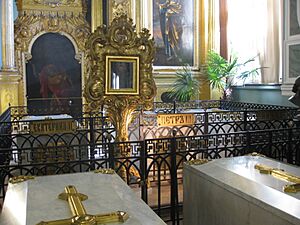
After Peter's death, four people claimed to be him. They were supported by revolts among people who believed a rumor that Peter had not died but was secretly imprisoned by Catherine. The most famous was a Cossack named Yemelyan Pugachev. He led a large rebellion in 1774, which Catherine's forces eventually stopped.
In December 1796, Peter's son, Emperor Paul I, became ruler after Catherine died. Paul did not like how his mother had treated his father. He arranged for Peter's remains to be dug up and reburied with full honors in the Peter and Paul Cathedral. This is where other Russian emperors are buried.
Local Stories
The story of Peter III is still talked about, especially in the town where he lived most of his life. This town was formerly called Oranienbaum and is now known as Lomonosov. It is located near St. Petersburg. Peter's palace there is special because it was the only famous palace in the St. Petersburg area that the Germans did not capture during World War II. During the war, the building was a school. People say that Peter's ghost protected the children of Oranienbaum from bombs. Also, the siege of Leningrad ended near this town in January 1944. Some people say that Peter, after his death, stopped Hitler's army near Leningrad, just as the living Peter had once ordered the Russian army to stop when it was about to capture Konigsberg.
Images for kids
See also
 In Spanish: Pedro III de Rusia para niños
In Spanish: Pedro III de Rusia para niños
- Family tree of Russian monarchs
- List of unsolved deaths


